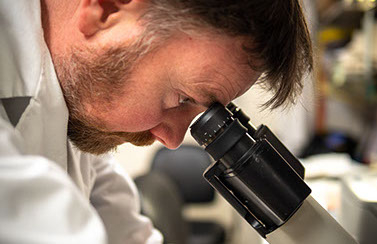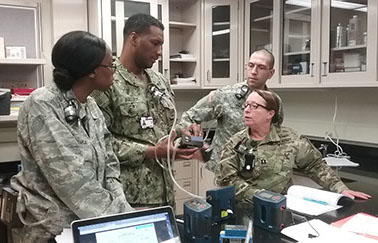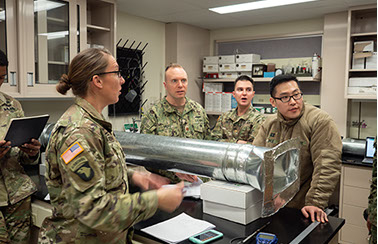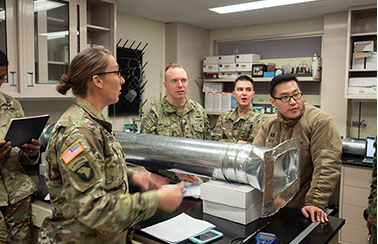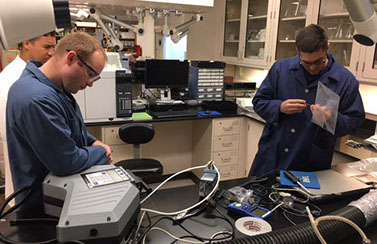INSIDE PMB LABS
We house six modern, inquiry-based labs that engage in active problem-solving of some of the most complex military, public health, and environmental hazards in the uniformed services. These learning spaces promote collaborative and mutually enriching connections among students and investigators across the DoD.
VECTOR BIOLOGY LABORATORY
OUR WORK
Previously known as the USU Entomology Lab, the Vector Biology Laboratory (VB Lab) is focused on investigating various aspects of the biology of vectors and the pathogens they transmit while developing mechanisms to reduce the impact of arthropod-borne disease vectors on U.S. Service members and individuals living in endemic areas. We conduct basic and applied research, develop best practices in integrated vector management (IVM) capacity building, and exploit our unique position at USU toward meaningful Global Health Engagements Programs through collaborations with DoD, NGO, US Government Agencies (USG), and Academics.
HISTORY
The Entomology Lab can trace its beginnings to Dr. Lance Sholdt (Navy), and Drs. Richard Andre and Don Roberts (Army), the first entomologists at USU. Over the years, many military and civilian entomologists have been involved in research focused on vector control and vector-borne disease prevention tools, or were trained in our MS or PhD programs in Medical Zoology, with many significant contributions in the areas of vector behavior and distribution, vectorial capacity, and vector control. Emerging from this rich history of contributions, it is the VB Lab’s goal to become the preeminent teaching and training facility for U.S. military and civilian personnel interested in a career contributing to advancements in vector biology and conducting vector control on a global scale as Civilian, Navy, Army, or Air Force entomologists. As Military Medicine evolves to protect service members’ increasing responsibilities and to help fulfill the DoD mission to engage partner nations in Global Health Engagements, the VB Lab is responding by leveraging new technological advances toward key questions, revolutionizing how IVM is conducted by combining new techniques and technologies with standardized, proven training, and engaging our graduate students in problem-solving skills to meet the challenges ahead.
FINDINGS
Current VB Lab projects include: 1) development of new personal protection repellents, 2) studying effectiveness and killing mechanisms of new larvicides, 3) paratransgenesis approaches to control transmission of Leishmania by sand fly vectors, 4) immunobiology of leishmaniasis, 5) identification and distribution of rickettsial pathogens in ticks, 6) surveillance and distribution of vectors and of vector-borne diseases, 7) collaborative studies with NGO, USG, DoD and partner nations to develop emergency response IVM teams.
MALARIA LABORATORY
The laboratory of Dr. V. Ann Stewart has been performing research on the molecular epidemiology of malaria since early 2011. Current projects include studying the impact of pre-symptomatic HIV carriage on malaria transmission and gametocyte dynamics, evaluating the true proportionality of non-falciparum species in sub-Saharan Africa, and looking at gene heterogeneity in vivax malaria in Peru. A panel of exquisitely specific assays for the detection of mixed malaria infections is in the process of being adopted for CAP/CLIA-certified human diagnostic use in the military.
INDUSTRIAL HYGIENE LABORATORY
The PMB Industrial Hygiene (IH) Laboratory offers state-of-the-art educational and research opportunities by serving as the learning hub for the hands-on technical aspects of occupational hygiene at USU. The laboratory is the designated instructional location for Industrial Hygiene and Lab and Industrial Ventilation. Laboratory instruction emphasizes the art and science of exposure assessment through fundamental and modern sampling and monitoring techniques for chemical, physical, and biological stressors. Students are instructed how to professionally communicate results and recommendations from occupational workplace investigations along with sampling and laboratory results to commanders, leaders, and managers. A wide array of IH instrumentation is available to support course and research objectives for students, including direct-reading gas, vapor, and particulate monitoring equipment, air sampling pumps, sound level meters, noise dosimeters, and ventilation measurement equipment. Past research projects supported by this lab have included: characterization of total (24-hour) noise exposures on U.S. Navy aircraft carriers, assessment of o-chlorobenzylidene malononitrile (CS riot control agent) exposure during mask confidence training, and determination of airborne dichlorvos exposures in a military guard post.
WATER LABORATORY
The PMB Water Laboratory serves a dual purpose for course instruction and student environmental health research on the effects of chemical and biological hazards with military public health significance. The laboratory is one of three designated locations for instruction of the Environmental Chemistry course and the Hydrology, Water Treatment, and Wastewater Treatment course. To achieve course learning objects students focus on the use of direct-reading and field-portable instrumentation for analysis of biological and chemical contamination of surface, ground, and treated water sources. Past research projects supported by this lab have included: evaluating the impact of ambient benzene vapor on product water from condensation water from air technology and impact of temperature and storage duration on chemical and odor quality of military packaged water.


ANALYTICAL ENVIRONMENTAL HEALTH LABORATORY
The PMB Analytical Environmental Health (EH) Laboratory studies the effects of chemical, physical, and biological hazards encountered by military, public health, environmental, emergency response, and law enforcement agencies. The laboratory is also the designated instructional location for Analytical Instrumentation in Environmental Health and Environmental Chemistry laboratory courses. Research conducted in this lab emphasizes real-time exposure assessment and focuses on the use of existing, novel, and experimental instruments and methods.
The EH lab provides masters and doctoral level graduate students the opportunity for hands-on experience with powerful technologies, such as gas chromatography/mass spectrometry (GC/MS), that are commonly used for definitive analysis of environmental samples. Special emphasis is given to real-time and near real-time field friendly techniques that can deliver rapid and accurate results to on-scene commanders in civilian and military settings. Past projects have included investigation of Solid Phase Micro Extraction (SPME) fibers to identify organic compounds in air.
PAST RESEARCH COLLABORATIONS HAVE INCLUDED

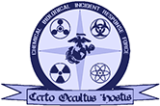
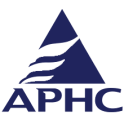
GEOGRAPHIC INFORMATION SYSTEMS/REMOTE SENSING LABORATORY
There is a growing use of Geographic Information Systems (GIS) and remote sensing in the field of public health, as well as a need for public health researchers to understand the capabilities of these systems. The Division of Tropical Public Health has a remote sensing and GIS lab for use by USU faculty and students for classes and research.
SOFTWARE IN THE LAB INCLUDES:
- ArcGIS Advanced with multiple extensions
- Various statistical software packages
COURSES IN GIS AND REMOTE SENSING:
- PMO577 Introduction to GIS in Public Health (2 Quarter Hours)
- PMO578 Remote Sensing Methods in Public Health (3 Quarter Hours)
- PMO1008 Independent Study in GIS (1-12 Quarter Hours)
EXAMPLE STUDENT AND FACULTY RESEARCH USING GIS AND REMOTE SENSING:
- Mosquito Habitats, Land Use, and Malaria Risk in Belize from Satellite Imagery
- Spatial Correlations of Mapped Malaria Rates with Environmental Factors in Belize Central America
- Use of IKONOS and Landsat for Malaria Control in the Republic of Korea
- A Cost Comparison of Two Malaria Control Methods in Kyunggi Province, Republic of Korea, Using Remote Sensing and Geographic Information Systems
- The Relationship between Mosquito Abundance and Rice Field Density in the Republic of Korea
- Modeling the Distribution of Culex tritaeniorhynchus to Predict Japanese Encephalitis in the Republic of Korea
- Ecological Niche Model of Phlebotomus alexandri and P. papatasi (Diptera: Psychodidae) in the Middle East

